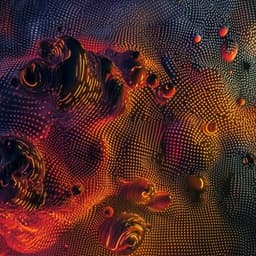
Engineering and Technology
An all-optical technique enables instantaneous single-shot demodulation of images at high frequency
S. Panigrahi, J. Fade, et al.
Transforming the landscape of optical signal processing, this innovative snapshot quadrature demodulation imaging technique effortlessly estimates amplitude and phase from a single acquisition—no synchronization needed! Developed by Swapnesh Panigrahi, Julien Fade, Romain Agaisse, Hema Ramachandran, and Mehdi Alouini, this all-optical approach unlocks high-frequency demodulation with impressive spatial resolution and continuous frequency selectivity.
~3 min • Beginner • English
Introduction
The paper addresses the challenge of performing high-frequency demodulation of wide-field optical images in a single snapshot. Conventional lock-in techniques enable extraction of weak signals by demodulating at a known modulation frequency but are typically implemented point-wise or require scanning, synchronization, or temporal sampling with specialized hardware (e.g., ToF sensors, image intensifiers). In imaging through complex disordered media, separating ballistic from diffusive light benefits from high-frequency modulation, pushing requirements into the RF/GHz regime, which has confined prior methods to point detection. Existing full-field approaches require electronic/mechanical/software processing, limiting speed and frequency. The authors propose an all-optical, wide-field, instantaneous quadrature demodulation approach that eliminates synchronization, enables continuous frequency tuning, and can, in principle, operate up to RF and beyond, thereby impacting applications in imaging through scattering media, 3D ranging, vibrometry, free-space communications, and autonomous vision.
Literature Review
The authors review lock-in detection and its use in optics for telemetry, communications, and imaging through scattering media. Time-gated methods offer efficiency but are costly; polarization and spatial modulation approaches are less expensive but have limitations. For ballistic imaging in turbid media, high modulation frequencies (10–100 MHz for transport/3D ranging; GHz for biological tissues) are advantageous. Prior RF modulation approaches are largely point-wise. Full-field demodulation using image intensifiers, ToF sensors, or lidar requires temporal sampling and often synchronization, scanning, or significant post-processing, restricting real-time, high-frequency operation. Quadrature demodulation in OCT has been demonstrated via temporal multiplexing, but not as continuous-time, full-field, snapshot quadrature demodulation. This gap motivates the proposed approach.
Methodology
Principle (FAST-QUAD): The method performs optical quadrature lock-in demodulation across the full image field simultaneously. An incoming intensity-modulated image at frequency f_m passes through an electro-optic (EO) crystal (e.g., LiNbO3) whose birefringence is driven by a high-voltage sawtooth waveform at demodulation frequency f_a, producing a 360° optical phase excursion per period. Using a polarizer, a quarter-wave plate (QWP), a Fresnel biprism (FP), and a Wollaston prism (WP), the system produces four transmission channels with sinusoidal transmittivities in quadrature (phases 0°, 90°, 180°, 270°). A standard camera records four sub-images (I1, Q1, I2, Q2) simultaneously during an exposure time much longer than the modulation period, effecting time integration analogous to electronic lock-in. From the four intensities at each pixel, the mean (DC) intensity, modulation amplitude, and phase are retrieved without needing phase synchronization with the source; only frequency tuning f_a ≈ f_m is required.
Optical setup: A prototype comprises: input polarizer (P); LiNbO3 EO crystal with axes at 45° to P; focusing lens L1 to an intermediate image plane with a field mask; recollimation lens L2; Fresnel biprism (splits beam); QWP in one arm to introduce a 90° phase shift; Wollaston prism for polarization separation into two beams per arm; imaging lens L3 onto a sCMOS camera, yielding four 300×300 pixel sub-images on a single sensor frame. The EO crystal (2×2×40 mm³) is driven by a calibrated high-voltage sawtooth (124 Vpp typical) from a function generator and high-voltage amplifier (±200 V, 0–0.6 MHz BW) to ensure 360° optical phase excursion. The LiNbO3 phase-voltage relation is ΔΦ(V) = π (r33/λ) (d/n^3) V with r33 ≈ 10 pm/V and n ≈ 2.2 at λ = 532 nm.
Acquisition and calibration: Experiments used a 532 nm green laser intensity-modulated externally to minimize chromatic dispersion effects (EO crystal, prisms, QWP). Raw images contain an isogyre interference pattern due to birefringence; however, the four quadrature patterns are in phase quadrature pixel-wise. Calibration and processing pipelines were developed (Supplementary Notes 1–2) to correct mechanical/optical imperfections and quadrature mismatch, yielding homogeneous demodulated amplitude and flat phase where expected.
Operation: The demodulation frequency f_a is tuned to match or scan around the source modulation f_m. Exposure times from 0.5 s to 2 s were used. The system supports continuous frequency tuning and snapshot demodulation in a single camera frame. Frequency selectivity is characterized by scanning Δf = f_a − f_m and measuring demodulated amplitude across the FOV.
Key Findings
- Demonstrated snapshot, full-field quadrature demodulation (amplitude and phase) from a single camera frame without source-receiver synchronization.
- Spatial resolution: four sub-images of approximately 300×300 pixels (field of view ~280×280 pixels used in examples) with good homogeneity after calibration.
- Operating frequency range: DC to 500 kHz demonstrated; 500 kHz was the cutoff with this prototype due to the high-voltage amplifier bandwidth (0–0.6 MHz) rather than the EO effect.
- Frequency selectivity: For 2 s exposure, demodulation bandwidth FWHM ≈ 0.5 Hz at f_a = 5 kHz and at 100 kHz; for 0.5 s exposure, FWHM ≈ 2 Hz, consistent with inverse exposure time scaling. Selectivity uniform across the FOV (evaluated with 8×8 pixel binning), with some degradation at higher frequencies or shorter exposures.
- Tuning and discrimination: Successfully discriminated two objects modulated at 5.00 kHz and 5.01 kHz by tuning f_a accordingly, producing snapshot filtered images of each object in the amplitude map.
- Robustness to unmodulated background: Demodulated amplitude negligible for unmodulated white light illumination, simulating strong ambient light.
- Encryption demonstration: An intensity-modulated hidden image (5 kHz) embedded in an unmodulated background is invisible on conventional intensity images but recovered in the modulation amplitude map when f_a matches the sender’s frequency; mismatched f_a fails to reveal it.
- Phase retrieval: When f_a = f_m, phase maps are flat as expected; detuning introduces spatial phase patterns attributed to residual phase mismatch across the isogyre, mitigated by calibration.
Discussion
The proposed FAST-QUAD system addresses the need for real-time, full-field demodulation at high frequencies by transferring quadrature lock-in detection into the optical domain. By generating four optical transmission channels in quadrature and integrating on a conventional camera, the system eliminates the need for electronic temporal sampling, scanning, or phase synchronization. The demonstrated narrow frequency selectivity, scalable with exposure time, enables discrimination among multiple emitters in cluttered scenes and supports applications such as de-cluttering for navigation and multi-channel free-space communications. The negligible response to unmodulated light shows strong rejection of ambient illumination, beneficial for imaging through scattering media and in outdoor conditions. While current performance is limited to ≤500 kHz by the drive electronics, the underlying EO effect is intrinsically fast (picosecond response), suggesting feasibility at tens of MHz to GHz with improved drivers and optical design. Uniform selectivity across the FOV and accurate amplitude/phase retrieval confirm that a single-shot, wide-field lock-in is practical, opening paths to vibrometry, spatially resolved high-frequency lock-in detection, and potentially high-resolution 3D ranging when extended to UHF/GHz modulation.
Conclusion
The study introduces FAST-QUAD, an all-optical, snapshot quadrature demodulation technique that retrieves amplitude and phase maps from a single camera frame without source-receiver synchronization and with continuous frequency tuning. A proof-of-principle prototype demonstrated operation from DC to 500 kHz, sub-Hz frequency selectivity dependent on exposure time, robust rejection of unmodulated background, and practical applications including frequency-based de-cluttering and image encryption. The approach is compact and compatible with conventional cameras. Future work aims to extend operation to tens of MHz–GHz by optimizing EO crystal dimensions and optical design (favoring achromatic elements), and by developing high-frequency high-voltage ramp generators. Additional directions include balancing laser linewidth requirements for demodulation efficiency versus speckle reduction, improving numerical aperture and resolution, and removing the need for narrowband illumination.
Limitations
- Bandwidth limited by the available high-voltage amplifier (0–0.6 MHz), yielding practical operation up to ~500 kHz in this prototype; not a fundamental EO limit.
- Significant chromatic dispersion in EO crystal, prisms, and QWP necessitated narrowband (532 nm) laser illumination; broadband use would require achromatic design.
- Presence of isogyre interference patterns in raw images required calibration and post-processing to correct quadrature mismatch and phase nonuniformities.
- Demodulation efficiency and uniformity degrade at higher modulation frequencies and/or shorter exposure times with the current setup.
- Requires application of relatively high-voltage sawtooth waveforms with precise 360° phase excursion, posing engineering challenges for MHz–GHz operation.
- Field-of-view and resolution constrained by EO crystal aperture and optical layout; optimization needed to improve NA and resolution while keeping voltage requirements reasonable.
- Conflicting requirements on laser illumination linewidth (demodulation versus speckle reduction) remain to be balanced in future implementations.
Related Publications
Explore these studies to deepen your understanding of the subject.







